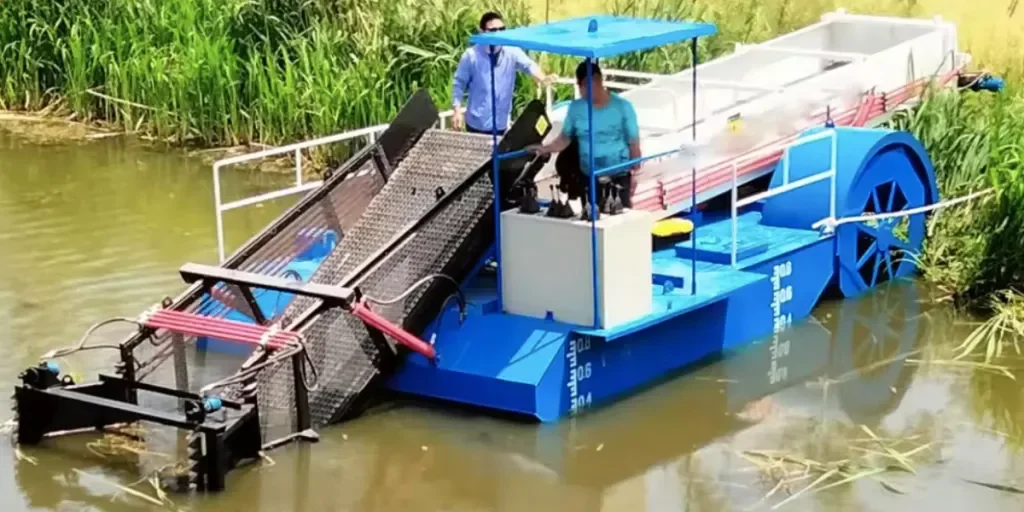Aquatic harvesting is a very necessary task to keep rivers and waterways free of invasive and congesting weeds and other water plants. Aquatic harvesters are becoming increasingly popular as a way to cut and remove aquatic plants that impact waterway quality.
This article reviews how these machines work, and it highlights some of the best models available in the online market in 2024.
Table of Contents
The projected global market for aquatic harvesters
What is an aquatic harvester?
Structure of an aquatic harvester
What to consider when selecting an aquatic harvester
A selection of aquatic harvester models available
Advanced technology robot harvesters
Final thoughts
The projected global market for aquatic harvesters
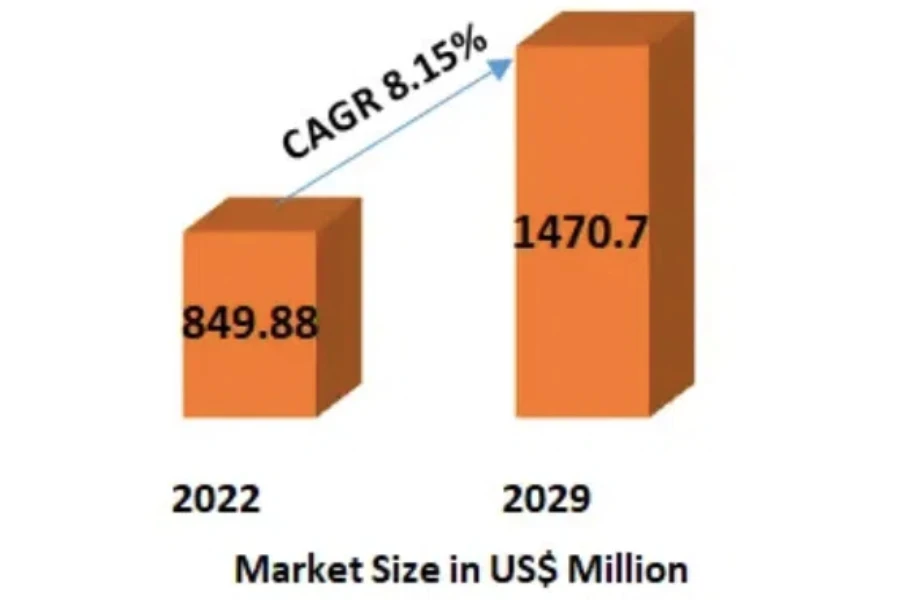
Aquatic harvesters are becoming more of a requirement for many urban and rural waterways, to remove excessive aquatic plant growth that can block and overrun rivers and drainage to prevent them from flowing.
The global aquatic harvester market showed a value of US$8 49.88 million in 2022. This is projected to grow by a compound annual growth rate (CAGR) of 8.15% to hit US$ 1470.7 million by 2029.
This healthy growth rate is due to an increasing awareness of preserving and improving water quality, the environmental benefits of free flowing waterways, and more awareness of the problems associated with unchecked growth of harmful aquatic plants.
Aquatic harvesters are also used to clean waterways of plastics and other polluting refuse that is becoming an increasing blight on rivers and streams, drainage and irrigation.
What is an aquatic harvester?
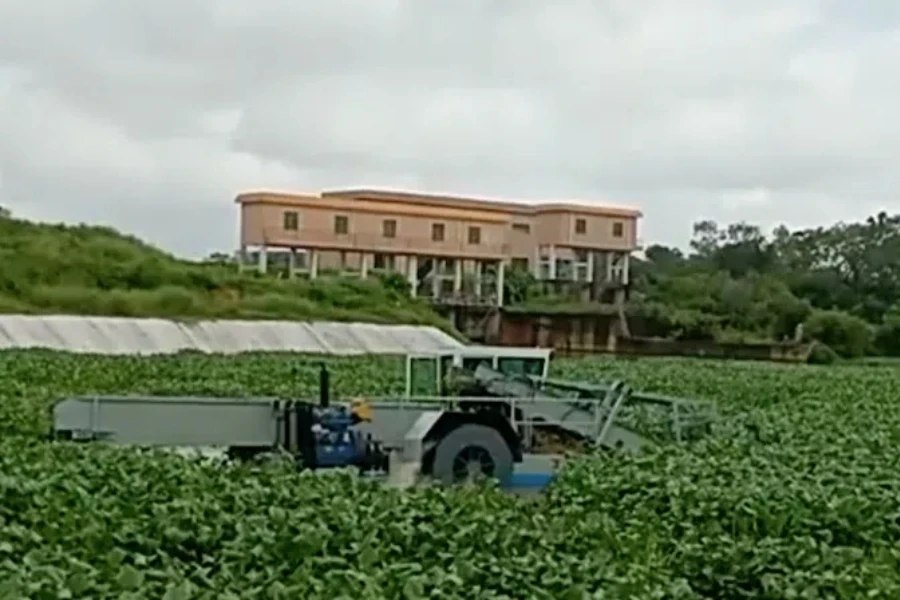
An aquatic harvester is a machine used for removing unwanted aquatic plants from waterways. There is a wide range of problematic aquatic plants including reeds and weeds, water hyacinth, pondweed, bullrushes, lily pads, and other types of plant life that grow in the water. These plants take root in the submerged soil, with some reaching the surface and others fully submerged.
Unwanted plant life can block rivers and canals, impede boats, slow or block water flow and drainage, and interfere with healthy growth of wildlife. Rotting water plants can also contribute to build up of sediment that further impedes waterways.
Aquatic harvesters, also called weed cutting boats, are used to remove these aquatic plants by cutting the stems underwater, or by pulling them up by the roots. Surface plants and floating residue are skimmed and gathered. These are then fed onto a conveyor belt up to the harvester, where they can later either be dumped, or recycled as animal feed or fertilizer.
These harvesters are also sometimes used to gather floating rubbish to clean polluted waterways, by skimming the surface and feeding the debris up to the boat.
Structure of an aquatic harvester
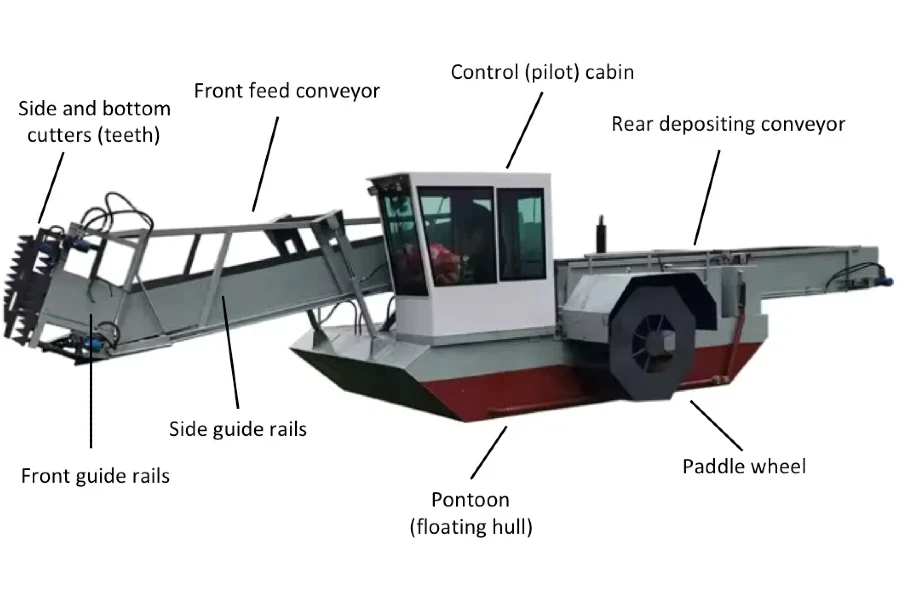
Aquatic harvesters are designed to float on water. They are fitted with a pontoon floating hull, and with paddle wheels on either side for propulsion, although some models use an outboard propeller.
Aquatic harvesters either have a closed control (pilot) cabin, or may have open controls covered by a sunroof. Engines are usually diesel powered, but there may be gasoline or electric models available.
Aquatic harvesters are designed to harvest in shallow depths, using a front feed conveyor belt that lowers down into the water to a depth of around 6 feet (1.82m).
At the front of the conveyor are sets of side and bottom cutters, one horizontal cutting bar across the front of the conveyor and a vertical cutting bar on each side of the conveyor.
Some models offer spinning wheel knives instead of side cutters. The conveyor has raised guide rails to direct the cut plants, and may also have small guide rails that open up to gather floating debris. The conveyor is raised and lowered with hydraulics.
There is a second rear depositing conveyor on the harvester. The cut plants are moved up from the water and deposited onto the boat, where the second conveyor moves the plants to the back of the harvester.
Aquatic harvesters come in different sizes and lengths. A longer conveyor belt will allow for deeper harvesting (cutting depth), whereas a wider conveyor belt can cut more plants than a narrower one (working width).
A longer boat body will allow for more cut plants to be held on board, thereby allowing the harvester to continue working longer without having to return to shore to offload.
What to consider when selecting an aquatic harvester
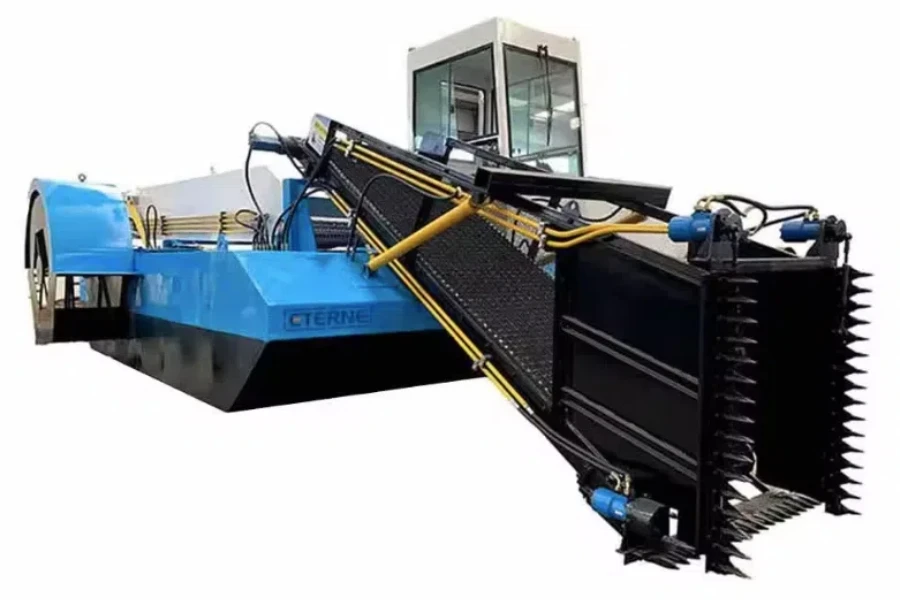
Looking at the diagram in the previous section, showing the key components of an aquatic harvester, the harvesting capability can be determined by a few key factors:
- working width and type of cutting teeth,
- underwater cutting depth, and empty/full pontoon draft,
- weight of the harvester versus its engine power,
- length and capacity of the front and rear conveyors and the onboard storage.
The working width is the width of the conveyor opening. This determines how much aquatic growth can be cut in a single pass. Working width usually varies between 40” to 80” (1 – 2m). The above image shows an aquatic harvester with a working width of 47” (1.2m), and also nicely shows the horizontal and vertical cutting teeth and conveyor hydraulics.
The underwater cutting depth determines how deep the harvester can cut, and the buyer should be aware of the depth of the intended waterways. Add to this consideration, the unloaded and loaded pontoon draft (depth that it sits in the water), as a loaded boat will sit lower in the water and allow more depth for cutting. Cutting depth usually varies between around 3 ft to 6 ft (91-182cm).
The overall weight of the harvester and the engine power, referred to as tractor power and expressed in horsepower (Hp). The harvester needs to have sufficient drive power to push through resistant weeds and underwater roots, as an underpowered engine will struggle and the harvester can get stuck. Typical tractor power ranges are from 10 to 100 Hp.
Length and capacity of the front and rear conveyors, and size of the onboard hold for collecting cut plants. The harvester will collect and hold cut plants until the hold is full, after which it must then return to shore to offload all cut growth. The greater the capacity of onboard storage, the more the harvester can work before returning.
A selection of aquatic harvester models available
This section looks at a few selected examples of aquatic harvesters available on Alibaba.com.
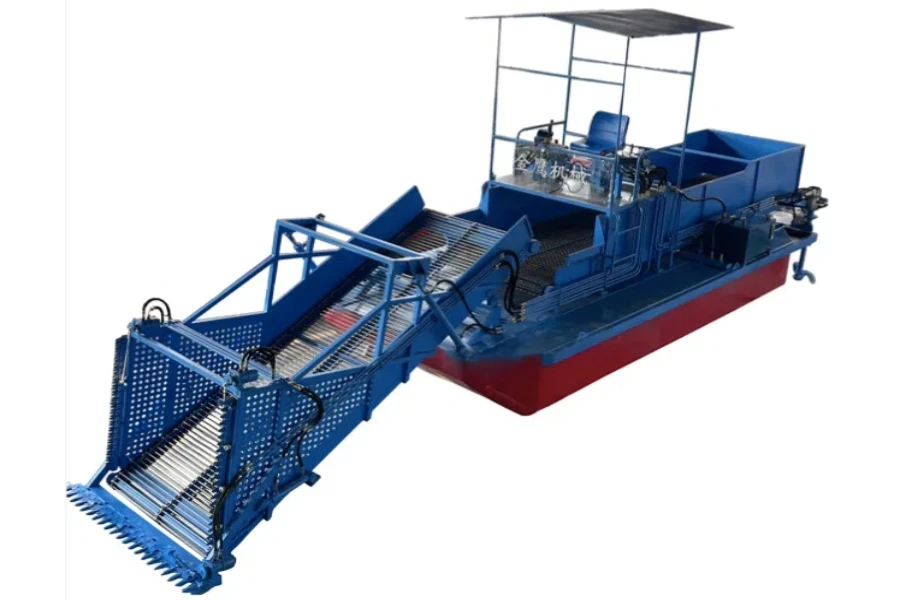
The above model is an aquatic weed harvester offered for river and lake salvage and cleaning. It has a working width of 57” (1.45m) and a cutting depth of between 10” and 43” (0.25m and 1.1m). The engine provides between 12 to 30 Hp. This harvester is available for between US$ 28,000 and US$ 31,000 depending on the number of units ordered.
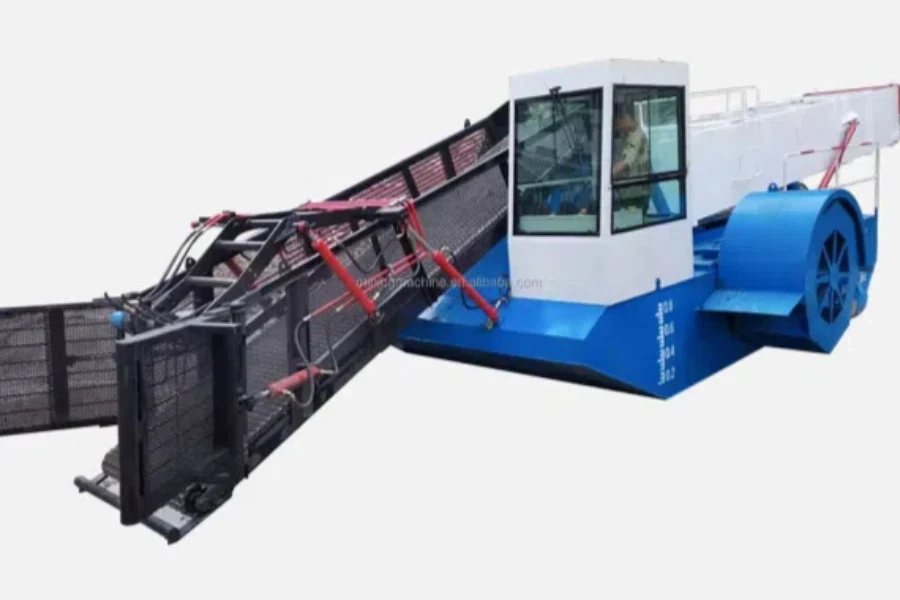
This aquatic harvester for weeds and water hyacinth has a tractor power range between 30 Hp and 80 Hp. This model has a working width of 59” (1.5m) and a cutting depth of 39” (1m). It is available for US$ 16,000.
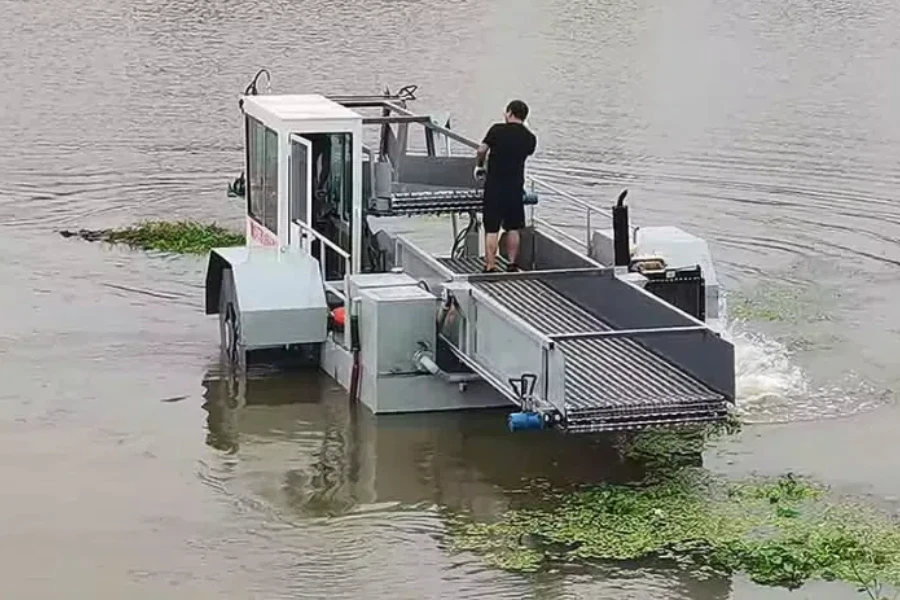
This aquatic harvester model is advertised as a water weed harvester and also as a river trash cleaner. It has a working width of 78” (2m) and a cutting depth of up to 43” (1.1m). Units are available for between US$14,000 and US$ 20,000 depending on numbers ordered.
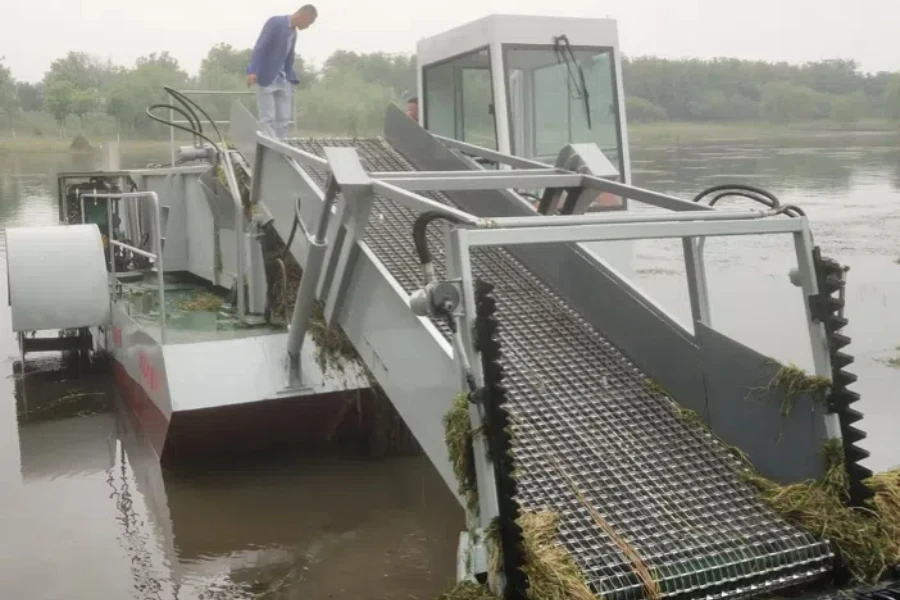
The above aquatic harvester is described as a river cleaning machine to cut aquatic weeds and collect floating trash in reservoirs, rivers and lakes. The working width is 67” (1.7m) and cutting depth of 43” (1.1m). The tractor power has between 45 and 55 Hp, and this model is available for between US$ 12,000 and US$ 63,000.
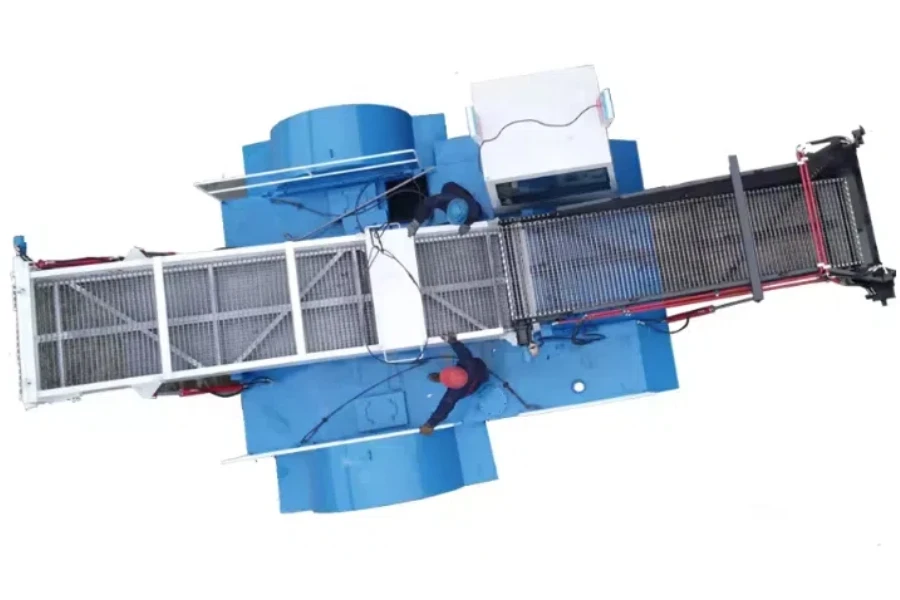
The above model is shown from the top view which nicely highlights the front cutting conveyor and the rear stacking conveyor, as well as showing the paddle wheels on each side. This aquatic harvester is described as an underwater grass and weed cutter, with a working width of 78” (2m) and a cutting depth of 32” to 39” (0.8m to 1m). It is priced at US$ 32,800.
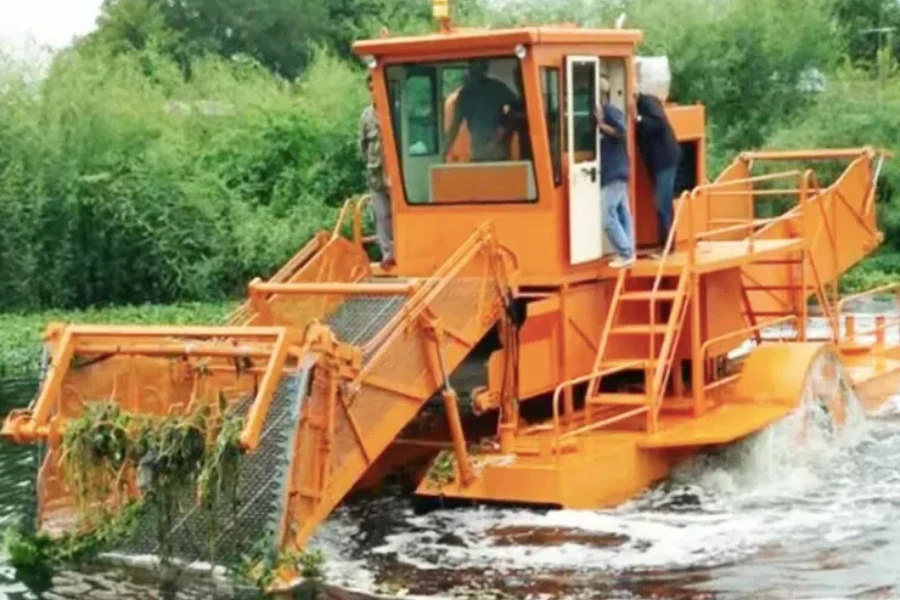
This aquatic weed harvester from China has a wide working width of 98” (2.5m) and a cutting depth of 59” (1.5m). It has a tractor power of 100 Hp. Larger models are available at between US$ 30,000 and US$ 150,000.
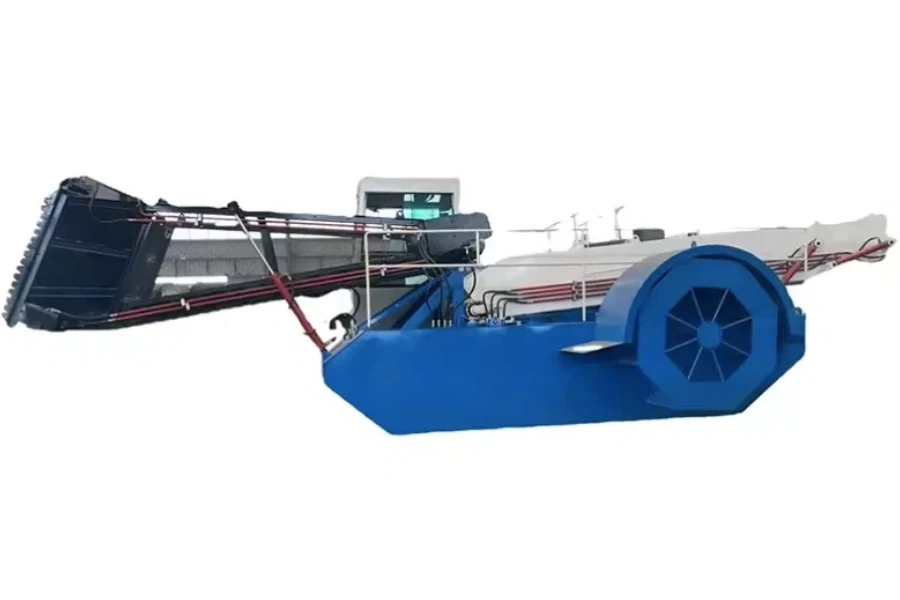
The above model is suitable for aquatic plant harvesting as well as for trash skimming. The harvester is advertised as having fully automatic function, with a 95% effective uprooting. It has a working width of 32” (0.8m) and comes with engine power of 50 to 56 Hp. Prices range from US$ 9,100 to US$ 9,300 subject to number of units.
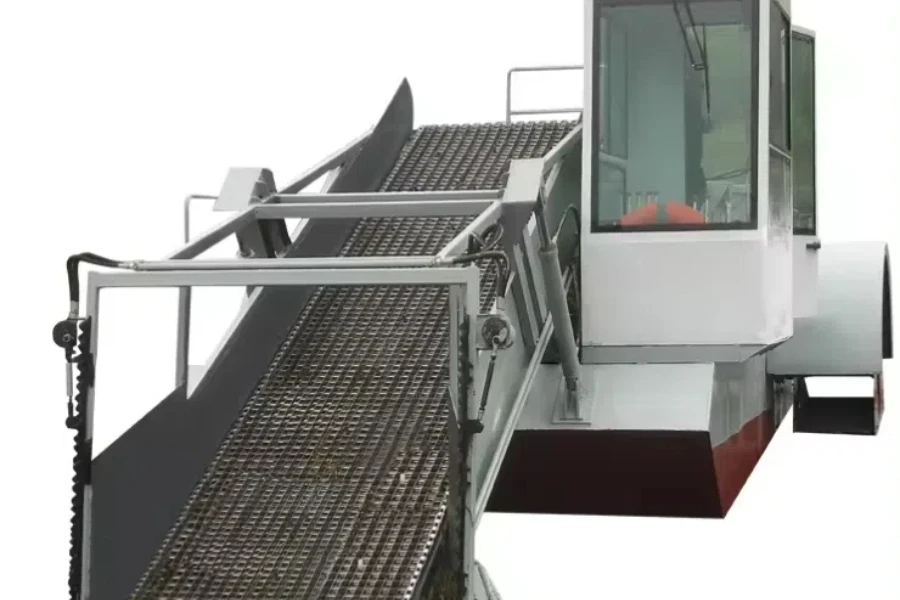
This model of aquatic harvester is advertised for seagrass, weed and trash removal. Machine options vary, with a working width variable from 47” to 78” (1.2m to 2m), and a cutting depth varying from 20” to 47” (0.5m to 1.2m). Engine power options are from 30 to 90 Hp. Pricing is from US$ 11,000 to US$ 12,000.

This model of aquatic harvester comes with a fully automatic feature and is advertised for cleaning and skimming river weeds and floating trash. This version has a working width of 78” (2m), using rotating wheel knives instead of vertical cutters.
It has a cutting depth of 10” to 33” (0.25 to 0.85m). Tractor power is between 10 and 12 Hp, and price availability is between US$ 10,500 and US$ 11,000.00.
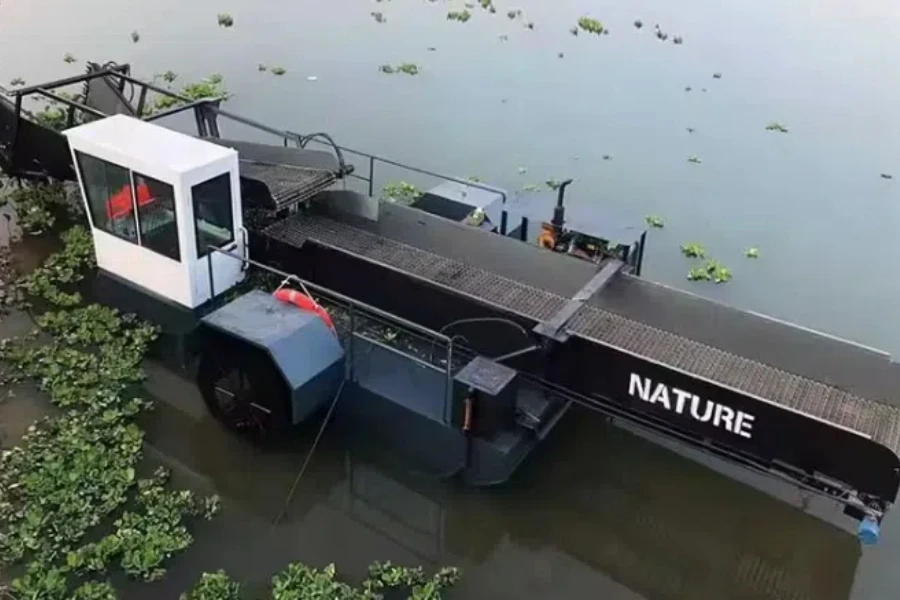
This automatic aquatic harvester, viewed from the top, shows how the rear conveyor can hold cut plants or can discharge them from the rear of the boat. This model has a working width of 78” (2m) and a cutting depth of 43” (1.1m). Its tractor power is between 30 and 50 Hp, and price is between US$ 14,000 and US$ 20,000.
Advanced technology robot harvesters
The advance in technology applications has also reached the world of aquatic harvesting, with two robot models shown here.
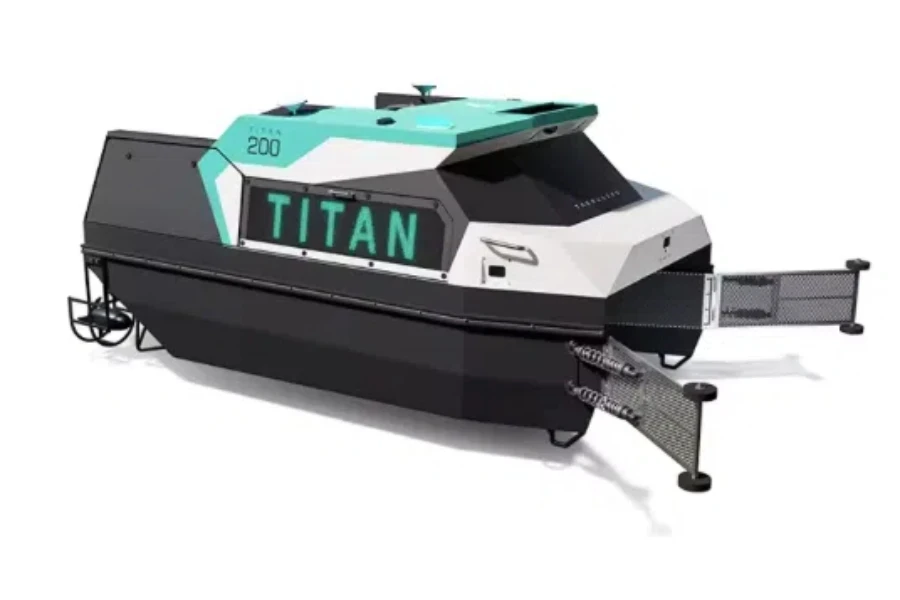
This Titan brand robot aquatic harvester operates on a number of different automatic function settings, to clean waterways automatically. This unmanned harvester does not cut underwater plants, but it does skim surface plants and algae, and can be used for rubbish cleaning. It also has functions to test water quality.
This model has a working width of 67” (1.7m), with an electric-powered engine that produces between 85 and 200 Hp, for a working time of up to 6 hours. Price is not surprisingly significantly more than other models, at between US$ 72,499 and US$ 75,499.
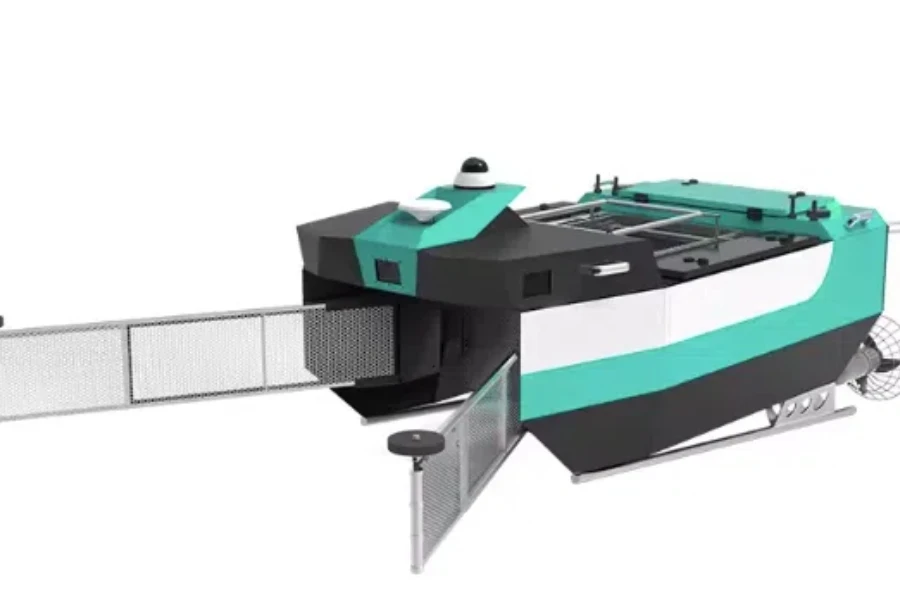
This model of robot aquatic harvester has multi-function capabilities including surface skimming and cleaning, water quality analysis, water depth detection, and inspection and detection functions. As with the Titan model, this robot harvester cannot cut underwater plants, and is designed for surface cleaning of floating plants and algae, and for collecting floating rubbish.
This model has a working width of 67” (1.7m), with an electric-powered engine that produces between 85 and 200 Hp, for a working time of 8-10 hours. Price is between US$ 39,499 and US$ 41,499.
Final thoughts
There is a wide range of aquatic harvesters available, so the potential buyer should narrow down options based on the intended applications. Most machines advertise for certain plants or for rubbish clearing, but actually most models are capable of handling a wide range of tasks.
The main considerations should be size, and sufficient power to handle that size, desired working width and expected working depth. Different plant types harvest differently and surface plants and algae need to be skimmed rather than cut.
Most machines are diesel powered, which are not very environmentally friendly. Electric models currently seem to be limited to smaller robot or semi-autonomous models.
Potential buyers can find more information on the wide range of aquatic harvesters available at the Alibaba.com showroom.
